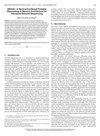X-PPR: Post Package Repair for CXL Memory
IF 1.4
3区 计算机科学
Q4 COMPUTER SCIENCE, HARDWARE & ARCHITECTURE
引用次数: 0
Abstract
CXL is an emerging interface that can cost-efficiently expand the capacity and bandwidth of servers, recycling DRAM modules from retired servers. Such DRAM modules, however, will likely have many uncorrectable faulty words due to years of strenuous use in datacenters. To repair faulty words in the field, a few solutions based on Post Package Repair (PPR) and memory offlining have been proposed. Nonetheless, they are either unable to fix thousands of faulty words or prone to causing severe memory fragmentation, as they operate at the granularity of DRAM row and memory page addresses, respectively. In this work, for cost-efficient use of recycled DRAM modules with thousands of faulty words, we propose CXL-PPR (X-PPR), exploiting the CXL’s support for near-memory processing and variable memory access latency. We demonstrate that X-PPR implemented in a commercial CXL device with DDR4 DRAM modules can handle a faulty bit probability that isX-PPR: CXL内存的包后修复
CXL是一种新兴的接口,可以经济高效地扩展服务器的容量和带宽,回收退役服务器的DRAM模块。但是,由于在数据中心的长期使用,这种DRAM模块有可能存在许多无法纠正的错误字。针对现场错误词的修复,提出了基于包后修复(Post Package repair, PPR)和内存离线的几种解决方案。尽管如此,它们要么无法修复数千个错误的单词,要么容易导致严重的内存碎片,因为它们分别以DRAM行和内存页地址的粒度进行操作。在这项工作中,为了经济高效地使用具有数千个错误字的回收DRAM模块,我们提出了CXL- ppr (X-PPR),利用CXL对近内存处理和可变内存访问延迟的支持。我们证明了在具有DDR4 DRAM模块的商业CXL器件中实现的X-PPR可以处理比512GB DRAM模块的ECC高3.3 \ × 10^{4}$的错误位概率。同时,X-PPR可以忽略不计地降低流行的内存密集型基准测试的性能,这是通过X-PPR中设计的两种机制来实现的,以最大限度地减少修复错误字所需的额外DRAM访问对性能的影响。
本文章由计算机程序翻译,如有差异,请以英文原文为准。
求助全文
约1分钟内获得全文
求助全文
来源期刊

IEEE Computer Architecture Letters
COMPUTER SCIENCE, HARDWARE & ARCHITECTURE-
CiteScore
4.60
自引率
4.30%
发文量
29
期刊介绍:
IEEE Computer Architecture Letters is a rigorously peer-reviewed forum for publishing early, high-impact results in the areas of uni- and multiprocessor computer systems, computer architecture, microarchitecture, workload characterization, performance evaluation and simulation techniques, and power-aware computing. Submissions are welcomed on any topic in computer architecture, especially but not limited to: microprocessor and multiprocessor systems, microarchitecture and ILP processors, workload characterization, performance evaluation and simulation techniques, compiler-hardware and operating system-hardware interactions, interconnect architectures, memory and cache systems, power and thermal issues at the architecture level, I/O architectures and techniques, independent validation of previously published results, analysis of unsuccessful techniques, domain-specific processor architectures (e.g., embedded, graphics, network, etc.), real-time and high-availability architectures, reconfigurable systems.
 求助内容:
求助内容: 应助结果提醒方式:
应助结果提醒方式:


